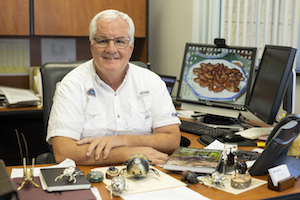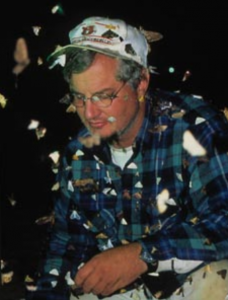For their work to complete five volumes on New World faunal surveys and taxonomy of a scarab beetle subfamily, a University of Florida scientist and his colleague have won the U.K.’s Royal Entomological Society’s J.O. Westwood Medal of Excellence.

Ronald D. Cave is director of UF’s Institute of Food and Agricultural Sciences Indian River Research and Education Center (IRREC) in Fort Pierce, Florida. Cave and his co-author, Brett C. Ratcliffe, professor and curator of insects at the University of Nebraska State Museum in Lincoln, Nebraska, are career colleagues who gather and compile data on the Western Hemispheres’ species of dynastine scarab beetles, also known as rhinoceros beetles and Hercules beetles, and sometimes identify species new to science.
Cave and Ratcliffe will be honored for their work, “Neotropical Dynastinae Monograph Series,” by members of the Royal Entomological Society at the next International Congress of Entomology, currently scheduled for July 2021 in Helsinki, Finland.
According to the Royal Entomology Society website, “in 2006, the Royal Entomological Society established a prestigious award aiming to encourage insect taxonomy, particularly revisionary work resulting in definitive monographs — the J.O. Westwood Medal for excellence in insect taxonomy.”
The first volume to appear, by Ratcliffe alone, addressed the fauna of Costa Rica and Panama. The book was followed by Cave and Ratcliffe’s work on the fauna of Honduras, Nicaragua, and El Salvador, then a tome covering the fauna of Mexico, Guatemala, and Belize, a monograph on the West Indian fauna, and finally a book on the dynastine scarab beetles of the U.S. and Canada. “In the five volumes, we treat 596 species, that is, we provide a description, diagnosis, distribution map and locality data, temporal activity data, natural history notes, and illustrations,” said Cave. “A total of 31 species are proposed as ‘new to science,’ meaning we described the species and named it, which is taxonomy.”
In a broad sense, Cave and Ratcliffe are Coleopterists, or beetle scientists. Together the professors published their monographs with keys for identify specimens to genus and species. Work to complete the monographs was funded by three grants from the National Science Foundation.
Since the Royal Entomological Society’s award selection for Cave and Ratcliffe’s work, a sixth monograph is in print for the dynastine scarab beetles in Ecuador, which was supported by funding from the National Geographic Society. They also have a journal article in review that covers the fauna in Chile. Currently, the two entomologists are at work on the dynastine scarab beetle fauna in Paraguay.
The monographs are peer-reviewed and range from 300 to 666 pages. On the front and back of each volume are full-color images of beetles. The elephant beetle, Megasoma elephas, on the back of “The Dynastine Scarab Beetles of Honduras, Nicaragua and El Salvador,” is double-winged. Its extended hind wings resemble bat wings; its front are hard, like armor. The male of the species sports four horns, the foremost of which is long, thick, and ends in a sharp 2-tined point.
“We find species in museums and in the field,” said Cave. “For fieldwork, we set up a vertical above a second sheet on the ground and hang a mercury vapor lamp in front of the vertical sheet. At dusk, we turn on the bright lights to attract insects, and if the collecting is good, we will work all through the night until dawn.”

Most dynastine scarab beetles are beneficial to natural ecosystems because the larvae decompose fallen logs and recycle forest nutrients and the adults are pollinators, while some are crop pests. “Males of many species are spectacular animals due to their armature and very large size,” Cave said. Cave and Ratcliffe will receive their own armature during the Helsinki award event, “a specially struck silver-gilt medal inscribed with J. O. Westwood’s name and image” wrote K.L. Whiteford, registrar for the award.
In the formal nomination letter submitted to judges of the Royal Entomology Society, Cave and Ratcliffe were recognized for laying a foundation “for understanding ecology, evolution, and conservation of this poorly known group of invertebrates; to train a generation of taxonomists, and to connect the natural world with citizen scientists and academics alike.”
Support letters were also submitted by scientists who represent the Smithsonian Institution, a professor with the Instituto de Ecología in Mexico, an entomologist at the Insectarium de Montréal in Canada, and an official with the U.S. Department of Agriculture.
“I am honored to receive this award and am looking forward to presenting our future work to the international entomology community,” said Cave.
 8
8
